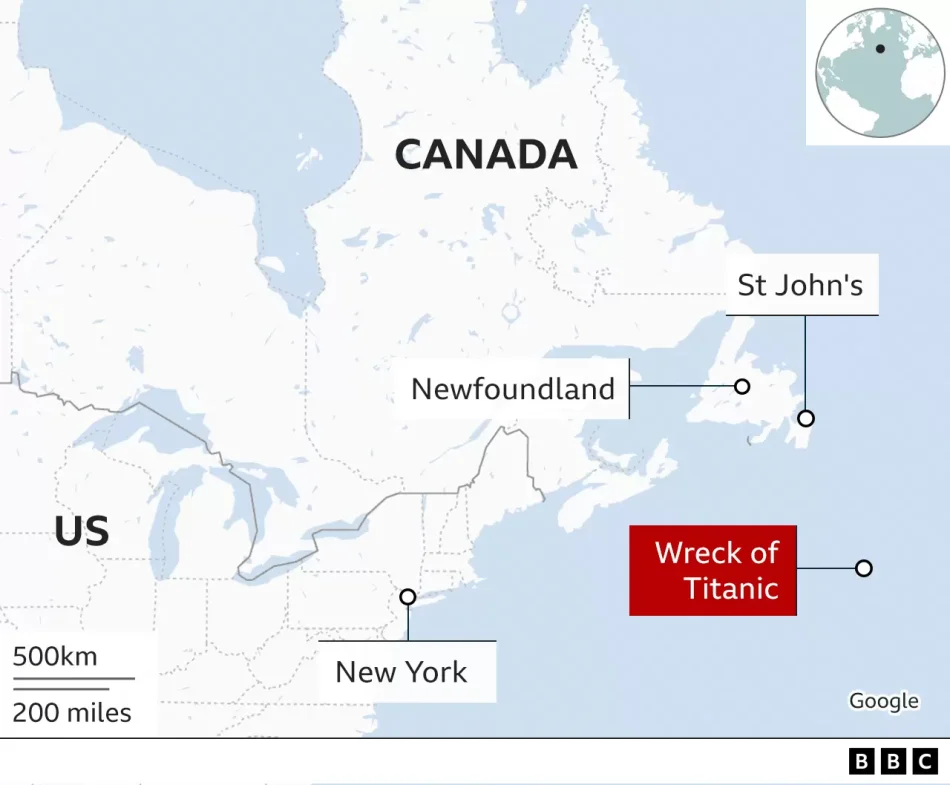Five dead on Titan sub were ‘true explorers’ – OceanGate
By Bernd Debusmann Jr From BBC News

DAWOOD FAMILY/LOTUS EYE PHOTOGRAPHY/REUTERSImage caption, Clockwise: Shahzada and Suleman Dawood, Hamish Harding, Paul-Henry Nargeolet and Stockton Rush
The five people who died on the Titan submersible were “true explorers”, the company who operated the dive has said.
The men “shared a distinct spirit of adventure,” said OceanGate in a statement.
The men died in what the US Coast Guard believes was a catastrophic implosion.
Five parts of the submersible were found on Thursday, approximately 1,600ft (487m) from the bow of the Titanic wreck. It had disappeared on Sunday.
The men on board the sub included Stockton Rush, the 61-year-old CEO of OceanGate, British-Pakistani businessman Shahzada Dawood, 48, and his son Suleman, 19, and British businessman Hamish Harding, 58.
The fifth man on board, Paul-Henry Nargeolet, was a 77-year-old former French navy diver and renowned explorer.

ENGRO CORPORATION/DH GROUP Image caption, Father and son Shahzada and Suleman Dawood pictured in March 2023 at Engros sports weekend in Pakistan
At a news conference on Thursday, Rear Adm John Mauger of the US Coast Guard said that the debris is believed to be consistent with the Titan submersible.
It is unclear what led to the destruction of the Titan or when the implosion occurred.
The disappearance of the vessel led to a massive international search involving US, Canadian, British and French teams.
In a statement, OceanGate said it appreciated “their commitment to finding these five explorers, and their days and nights of tireless work in support of our crew and their families”.
Among those to pay their tributes after the announcement was Richard Garriot de Cayeux, the President of the US-based Explorers Club, of which Mr Harding and Mr Nargeolet were members.

Rear Admiral John Mauger of the US Coast Guard confirms the Titan sub was lost
In a statement, he said that the organisation is “heartbroken” and that the memories of the men “will be a blessing and will continue to inspire us in the name of science and exploration”.
Dive expert David Mearns said he lost two friends, Mr Harding and Mr Nargeolet, in a “most horrific way”.
“Hamish Harding was a terrific character,” Mr Mearns said, adding that Mr Nargeolet was “almost a legend really” in the field of deep sea exploration.
Azmeh Dawood told NBC News that her nephew Suleman was “terrified” before going on the trip, but braved the journey because he was eager to please his father.
“I feel disbelief,” she said. “It’s an unreal situation.”
How was the wreckage found?
The debris was located by a remote-controlled underwater search vehicle (ROV).
Separate pieces were discovered that allowed authorities to confirm they came from the Titan, including a tail cone.
Rear Adm Mauger said he did not have an answer on whether the bodies of the five men on board were likely to be recovered.
“This is an incredibly unforgiving environment down there on the seafloor,” he said.
ROVs will remain in the area as the investigation into what happened continues, Rear Adm Mauger added, but search personnel – including medical experts and technicians – will begin be wound down over the next 24 hours.
Experts told the BBC that gathering and analysing the debris, particularly the carbon fibre that the main hull was made of, may shed some light on the cause of the disaster.
“In the case that this is a catastrophic failure of the main housing, the submersible would have been subjected to incredibly high pressures, equivalent to the weight of the Eiffel Tower, tens of thousands of tonnes, compressing the vessel,” said Professor Blair Thornton from the University of Southampton.
“We’re talking about a very powerful implosion of the main housing.”
Earlier this week, authorities said that Canadian aircraft had detected underwater sounds, which some experts speculated may have been a sign that the submersible’s passengers were still alive.
The Coast Guard now believes there was no connection between the noises and the location at which the debris was found on the sea floor.
The Titanic wreck site is approximately 370 miles (600km) off the coast of Newfoundland.

For more on this story and video go to: BBC
See also related BBC story: Titan sub debris field: Parts of missing sub’s cover found, expert says





